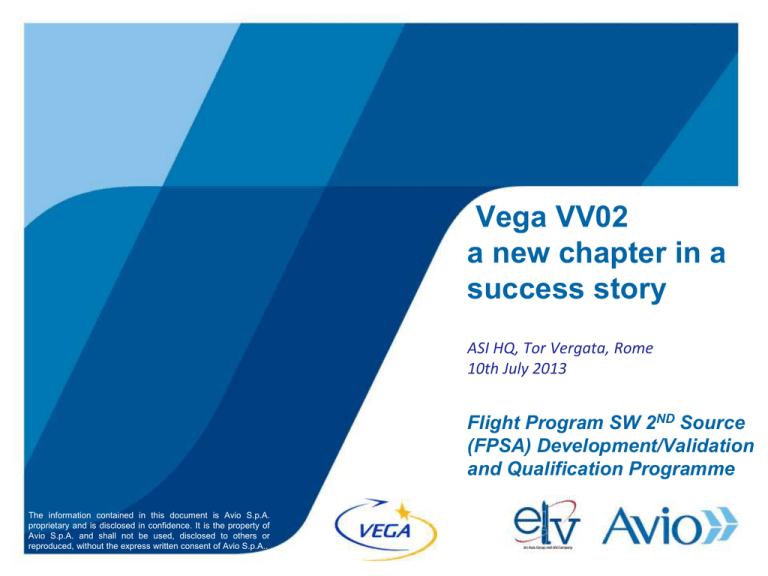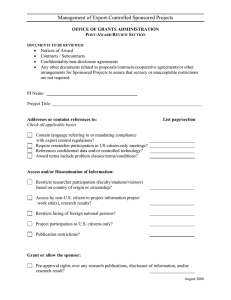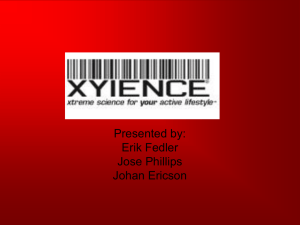The challenges of FPS-A
advertisement

Vega VV02 a new chapter in a success story ASI HQ, Tor Vergata, Rome 10th July 2013 Flight Program SW 2ND Source (FPSA) Development/Validation and Qualification Programme The information contained in this document is Avio S.p.A. proprietary and is disclosed in confidence. It is the property of Avio S.p.A. and shall not be used, disclosed to others or reproduced, without the express written consent of Avio S.p.A.. Chapter #1 – The challenges of FPS-A This venture sounds tough You definitely need help. (to fly, navigate, guide, control, separate the stages, to release the P/L…) Avio S.p.A. Proprietary Information – subject to the restrictions on the cover or first page 5 Chapter #2 – The challenges of FPS-A : the Teamwork To answer to the ESA challenging request, ELV as FPS Prime contractor, put in place a well committed industrial team, selecting the best competence and skills in Europe from GNC and SW disciplines, each with a specific role: AVIO (Italy) – Starting from TRR, AVIO activities have been performed by ELV Centro Italiano Ricerche Aerospaziali - Most in Colocation MBDA (Italy) – Partly in Colocation Telespazio (Italy) Spacebel (Belgium) - Most in Colocation GMV (Spain) - Most in Colocation SENER (Spain) for ISVV directly managed by ESA Avio S.p.A. Proprietary Information – subject to the restrictions on the cover or first page 6 6 6 Chapter #2 – The challenges of FPS-A : the Teamwork-Project Organization TELESPAZIO Avio S.p.A. Proprietary Information – subject to the restrictions on the cover or first page 7 Chapter #2 – The challenges of FPS-A : the Teamwork- Project Organization ELV Remote TELESPAZIO Program & Project Manager Local PA & RAMS MBDA AVIO/ELV SpaceBel CIRA GNC & SW Design Phase GMV GNC Algos SW System Design GNC Technical Responsible SW Technical Responsible GNC Development FPSA Detailed Design and Integration Phase Validation & Refinement Phase SW Technical Responsible SW Technical Responsible Qualification Phase SW Tools Development Phase SW Technical Responsible SW Technical Responsible GNC Simulation & RACS GNC support SW Technical Responsible SW Tecnical Responsible SW Technical Responsible GNC Support GNC DevelopmentTeam GNC Simulation & RACS Team GNC Support RACS Support FPSA Design Team FPSA Development Team Support to SW design Avio S.p.A. Proprietary Information – subject to the restrictions on the cover or first page Validation Team Qualification Team SW Tools Development Team OBC Simulator COMIT Development 8 Chapter #2 – The challenges of FPS-A : the Teamwork- Project Organization ELV roles: Is the LV System Prime and the FPS-A Design Authority: • Manages Program and Technical activities as prime contractor; • Defines the functional specifications and follows the development for the principal SW products (On Board Computer Software e SW tools); • Adapts and updates the simulation environments. Prepares the validation plans for the GNC algorithms and verifies the • Performs system activities. Defines, results; tunes and validates GNC algorithms in frequency/time domain; • Validates the integrated FPSA Products at SW & GNC level. Qualifies FPSA in HWIL platform. Avio S.p.A. Proprietary Information – subject to the restrictions on the cover or first page 9 Chapter #2 – The challenges of FPS-A : the Teamwork- Project Organization MBDA roles: Develop “Software Validation Facility” (SVF) used to perform the software validation tests of the FPSA SW. The SVF is developed in two benches: • SVF-SIM: simulated environment using the OBC Simulator • SVF-SDM: real-time environment using the OBC SW Development Model TELESPAZIO Verify the GNC algorithms : • Test Procedure • Simulation & Performance Assessment • Compliance Analysis Avio S.p.A. Proprietary Information – subject to the restrictions on the cover or first page 10 Chapter #2 – The challenges of FPS-A : the Teamwork- Project Organization Telespazio roles: • Detailed Design, Coding, Unit and part of Integration Testing of Flight Programme Software (FPS) Alternative TELESPAZIO • Operational flight implementation of Guidance, Navigation and Control (GNC) algorithms and their integration within FPSA • Development of GNC numerical validation tool (FPSSIM) to be used by ELV to validate GNC algorithms functionality in all different mission types • Development of the Sign Verification Software tool (SVS) to check LV actuators before uploading FPSA to the rocket itself Avio S.p.A. Proprietary Information – subject to the restrictions on the cover or first page 11 Chapter #2 – The challenges of FPS-A : the Teamwork- Project Organization CIRA roles: GNC Support activities on • Roll and Attitude Control Algorithm Design and Assessment for both the Propelled and the Ballistic Mission phases of the VEGA • Definition of the RACS Algorithm Verification Plan Two algorithms were compared under several aspects for the most relevant and sizing mission phases (P/L release – spinned and stabilized – and Long Coasting Phase): Switching Lines (SL) Quaternion Feedback Regulator (QFR) TELESPAZIO • Participating to Detailed Algorithm Development and Preliminary Assessment • Supporting the C-code prototype implementation and testing From VV02 flight outcomes, the RACS algorithms resulted more propellant efficient than the previous FPS architecture Avio S.p.A. Proprietary Information – subject to the restrictions on the cover or first page 12 Chapter #2 – The challenges of FPS-A : the Teamwork- Project Organization SpaceBel roles: • Develops and validates the OBC simulator, a model of the VEGA OBC, used in SVF platform to support the verification of the FPSA TELESPAZIO • Strongly and effectively involved in the definition and implementation of the Configuration and Missionization tool • Supports GNC team for consolidation of the FPSA GNC Engineering Code • Involved in the Optimisation of the missionization process • Supports SW team in the definition of FPSA Architecture and SW Tools Avio S.p.A. Proprietary Information – subject to the restrictions on the cover or first page 13 Chapter #2 – The challenges of FPS-A : the Teamwork- Project Organization GMV roles: • Provides support for the GNC development( consolidation phase); • Provides support to define and issue the relevant GNC algos Definition Files ; • Deeply involved in GNC Engineering code improvement during the preliminary phase of design; • Support for validation activities of GNC algos and relevant Test Report TELESPAZIO • Support for improvements on GNC algos to better manage all the LV flight phases mainly focus on Guidance/Navigation and RACS algos; • SW PA and RAMS activities Avio S.p.A. Proprietary Information – subject to the restrictions on the cover or first page 14 Chapter #3 – The challenges of FPS-A : Development logic in a tight schedule The FPSA is a Mission Critical SW and required special Development and testing Rules imposed by ESA ECSS rules and VEGA standards MR-90 and SG-34 Specific design at GNC/SW level have been performed to be compliant with: Safety constraints (stage re-entry and footprint reduction in adaptive mode in flight) LOS ( space debris meeting French law) mainly for AVUM de-orbiting phase FPSA has to be compatible with the VEGA Mission Scenario covering: P/L Mass range from 300 to 2500 Kg Orbit inclination : from Equatorial to SSO To manage the AVUM (Upper Stage) Re-ignition for a total of 5 ignitions Note that FPS developed by Astrium for VV_01 covered only mission “Type 2” with only 3 AVUM boosts The full FPSA qualification logic was designed to be compatible with all the technical needs and with a very tight schedule on which the main constraints was VV_02 (multi PL mission with 5 AVUM ignitions and 3 satellites released in different orbits). Avio S.p.A. Proprietary Information – subject to the restrictions on the cover or first page 15 Chapter #3 – The challenges of FPS-A : FPS Development logic in a tight schedule FPS Development Logic Avio S.p.A. Proprietary Information – subject to the restrictions on the cover or first page 16 Chapter #4 – The challenges of FPS-A : An original Development Logic To matches the technical and programme challenges the FPS-A development life cycle has been deeply optimized and presents several original features. Concurrent development of GNC algorithms and Software are managed through a Double V cycle with specific instances of integration between the two branches of development. ATPl, ATPr, QTPl, QTPr System Requirements Qualification (HWIL) Validated SW, VaTRe CF, SI VaTPl, VaTPr Technical Specification Validation ST, ICD Integrated SW, ITRe Architectural Design Integration HW/SW SW/SW ITPl, ITPr AD SW Modules, UTRe UTPl, UTPr Detailed Design Unit Tests SW Modules DD Coding Avio S.p.A. Proprietary Information – subject to the restrictions on the cover or first page 18 Chapter #4 – The challenges of FPS-A : FPS Development logic in a tight schedule Original Phasing and Planning 6 Months 18 Months 9 Months 1st Phase (up to PDR) Requirements Definition 2nd Phase (optional) SW Architect. Design SW Delta Design HWIL 6 Qualification GNC Design and Tuning SW Detailed Design SW Coding (incl. GNC) SW Integration and Testing System Activities OBCS Design. Auth. Act. SW Validation OBCS Dev. Activities SW Qualification (HWIL) SW Tools Dev. Activities SW Tools Development Avio S.p.A. Proprietary Information – subject to the restrictions on the cover or first page 19 SW Missionization SW Qualification (HWIL6) Chapter #4 – The challenges of FPS-A : An original Development Logic An original and innovative approach has been used into FPSA programme with the aim to include in the SW the multi-mission capabilities already provided by the launcher. The design foresees: Short time for SW reconfiguration: the mission timeline is defined as a configurable table-driven state machine that defines the ‘SW operating modes’ sequence and the actions to be performed in each state (for launcher and GNC management) Definition of pre-defined I/O messages towards external equipment (for commands and retrieval of data) generated through automatic exports of System Database Missionisation and Configuration tool which guarantees time saving during the flight parameters definition and the coherence/correctness of handled data and, at the same time, limit the recurrent production costs of the FPS missionized executable GNC library: designed as configurable module with defined I/F with the SW Key of success was the usage of the last (state of the art) technologies in terms of design tool, development environments and validation/ qualification platforms. Most of the tasks were supported by a concurrent infrastructure that allowed an effective management of technical facts and activities, among partners and customer. Avio S.p.A. Proprietary Information – subject to the restrictions on the cover or first page 21 Chapter #5 – The challenges of FPS-A : OBC functions in Flight The main functions of FPSA are to : Manage the LV main functions during flight (stage separations, motors ignitions…); Perform the GNC activities and guide the LV to the desired orbits (with required specified accuracy); Send Telemetry data to ground; Manage the On-Board Computer Hardware; Perform the De-orbit Manouvre and Passivation phases. The GNC algorithms and relevant flight management events have been designed to cover all needs at system level and satisfy the Launch Vehicle Main Function “To guide and control the LV to achieve required orbital conditions”. The GNC flight algorithms have been designed and developed to achieve this target taking into account each specific sub-tasks or sub-function. The LV control is based on the following loop , so called “big loop” Avio S.p.A. Proprietary Information – subject to the restrictions on the cover or first page 22 Chapter #6 – VV02 Mission VV_02 MISSION DESCRIPTION The second Vega launch from the Guiana Space Center (CSG) placed three satellites in different orbits: Main Payload: PROBA_V (140 Kg) PROBA_V : Project for On-Board Autonomy and Vegetation Secondary Payload: VNREDSat-1 (116 Kg) VNREDSat: Vietnam Natural Resources Environment & Disaster Monitoring Satellite Secondary Payload: ESTCube-1 Vega VV-02 Avio S.p.A. Proprietary Information – subject to the restrictions on the cover or first page (2Kg ) Chapter #6 – VV02 Mission VV02 mission was horribly demanding: • The Launch Vehicle had to act as a school bus, releasing three payloads, with first release on the higher orbit; a significant orbital plane change was necessary from Proba-V to Vnredsat. • The Payload Adapter (Vespa) had to be released in indirect re-entry orbit. • Several constraints due to safety RF links and TLM links had to be respected, implying, in example, roll attitude angle control during part of the ascent phase. • Five ignitions/cut-offs of the AVUM engine • Long duration of the mission (almost 3 hours) • High number of maneuvers for P/L thermal conditioning, release and pointings/CCAMs • AVUM Direct deorbiting • The mission implied a null launch window Record setting for Europe in terms of number of maneuvers, duration, first direct deorbiting… Vega VV-02 Avio S.p.A. Proprietary Information – subject to the restrictions on the cover or first page Chapter #6 – VV02 Mission Payloads Accomodation Vega VV-02 Avio S.p.A. Proprietary Information – subject to the restrictions on the cover or first page Chapter #7 – ALTS On the VV02 additional equipments were installed to better investigate the LV behavior during overall flight, so called “ALTS”. • GPS: working during all flight. • IMU: first 25 seconds, but data are considered “nice to have” up to H0 + 360 sec. • Shock sensors: mandatory during separation of Fairing, 3rd stage, Main P/L, VUP (VESPA Upper Part). Four sensors will separate with VUP. • Units housekeeping signals and temperature telemetries (RF TX and Battery): acquired during all the mission. • Internal (IC) and external (EC) cameras will be activated according to their mission: o IC1 will record the main payload separation. o IC2 will record the secondary payload and the VUP separation o IC3 is dedicated to record the Fairing separation o EC aims to record the separation of the lower stages and relative bodies kinematics. Vega VV-02 Avio S.p.A. Proprietary Information – subject to the restrictions on the cover or first page Chapter #8 – VV02 Mission : Results 1/2 From a SW point of view VV_02 was a complete success: • Flight Timeline scheduled as expected. No error detected; • Guide, Navigation and Control functions remarkably matching the predictions; • Launch vehicle managed correctly (ignitions, separations, avionics, …). At the end of mission, 1.9s of difference between expected and TLM timeline (over 8300s) • Telemetry data correctly sent to ground • Correct management of the OBC HW and of the 1553 Avio S.p.A. Proprietary Information – subject to the restrictions on the cover or first page 28 Chapter #8 – VV_02 Mission : Results 1/2 Vega Typical Mission VV02 Mission Profile 3 P/L were injected into 2 different orbits. 4th stage performed the direct re-entry into the Pacific Ocean Avio S.p.A. Proprietary Information – subject to the restrictions on the cover or first page 29 Chapter #8 – VV02 Mission : Results 2/2 Accuracy sensibly better than mission specification Avio S.p.A. Proprietary Information – subject to the restrictions on the cover or first page 30 Chapter #9 Vega – A true world of opportunities Vega Second Flight completes the process of qualification of the LV and start its (hopefully) long and honourable life as a space workhorse. The qualification of the FPS-A secures the industrial mastering of the Launch Vehicle system and open a true world of opportunities for users of the Launch System. In fact its flexibility allows right now missions whose implications are not yet explored in the field of In Orbit Testing, In Orbit Servicing, Active Debris Removal, Solar System Exploration (with Vega Electric Propulsion Module) and candidates as a optimal carrier for electric satellite to GEO. Spiral Raising orbit GE O Avio S.p.A. Proprietary Information – subject to the restrictions on the cover or first page 31 End of Mission Avio S.p.A. Proprietary Information – subject to the restrictions on the cover or first page 32

